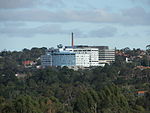Heidelberg railway station
Heidelberg, VictoriaPremium Melbourne railway stationsRailway stations in Australia opened in 1888Railway stations in MelbourneUse Australian English from February 2015

Heidelberg railway station is located on the Hurstbridge line in Victoria, Australia. It serves the north-eastern Melbourne suburb of Heidelberg, and opened on 8 May 1888.
Excerpt from the Wikipedia article Heidelberg railway station (License: CC BY-SA 3.0, Authors, Images).Heidelberg railway station
Yarra Street, Melbourne Heidelberg
Geographical coordinates (GPS) Address Website External links Nearby Places Show on map
Geographical coordinates (GPS)
| Latitude | Longitude |
|---|---|
| N -37.7571 ° | E 145.0607 ° |
Address
Platforms 1 & 2
Yarra Street
3079 Melbourne, Heidelberg
Victoria, Australia
Open on Google Maps




